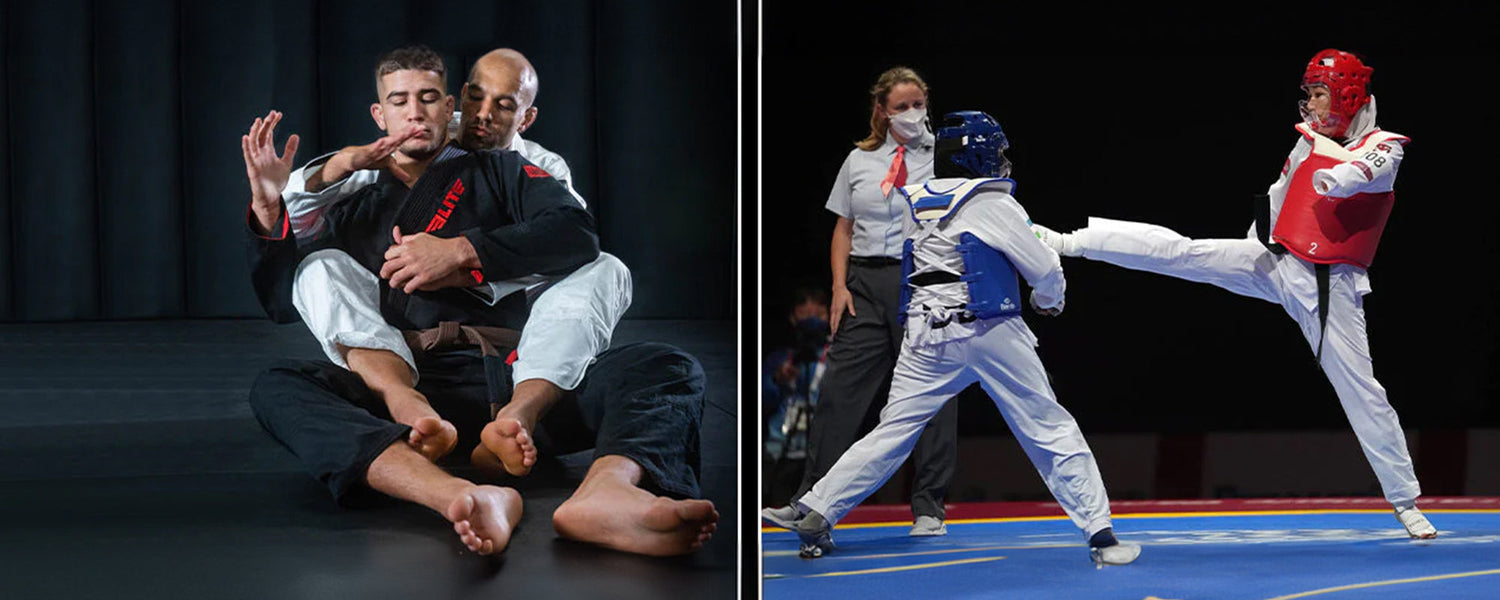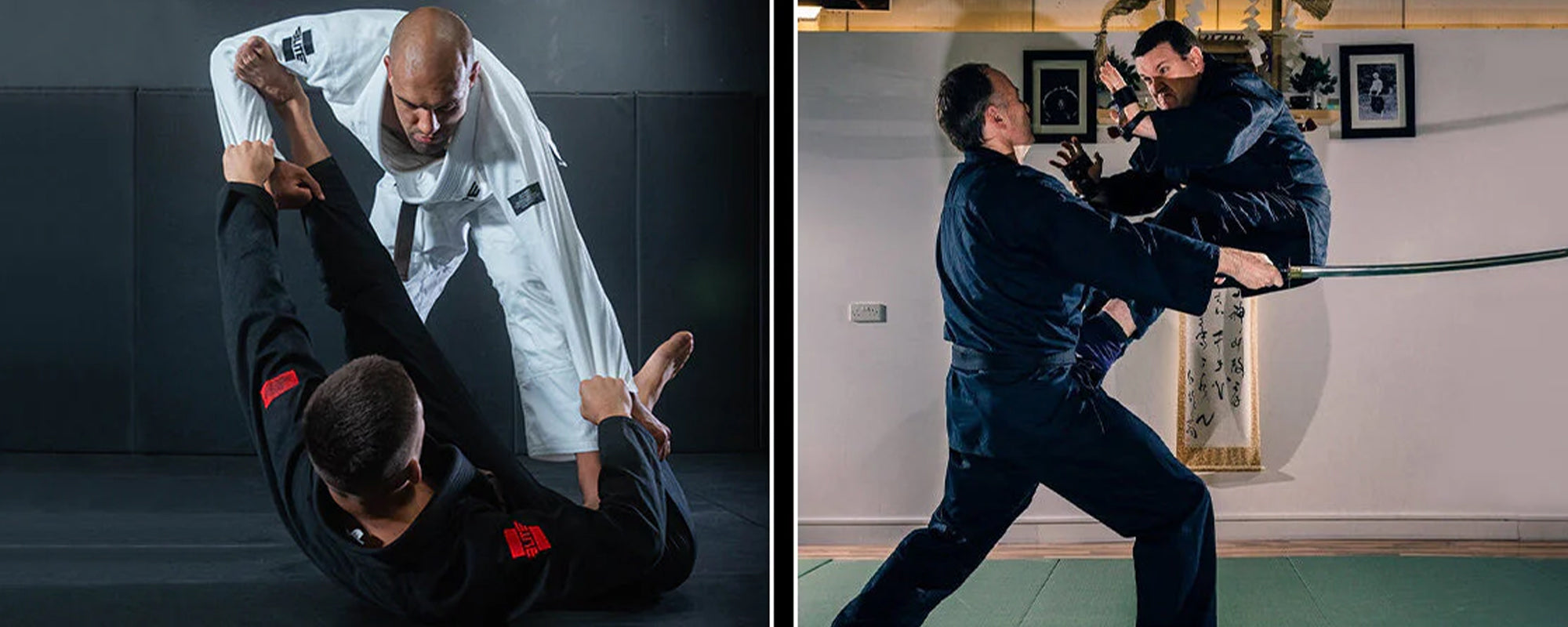Table of content
Brazilian Jiu-JItsu and Taekwondo are two martial arts based on grappling techniques and striking discipline respectively. Combining both is a great idea as it would hone both the grappling and striking skills of the practitioners.
1. Brazilian Jiu-Jitsu
Brazilian Jiu-JItsu is a martial art based on grappling techniques, which teaches one to control an opponent by manipulating body joints, applying choke holds, and submission attempts. In BJJ, one with lesser strength and size overcomes the other with more flexibility and agility if combined with BJJ techniques.

2. Taekwondo
The Korean form of martial arts Taekwondo concentrates mainly on a wide variety of kicks including, spin kick, axe kick, steven legrow, tornado kick, double jump kick, and standing defenses. Although it was first developed for self-defense, many people now utilize it for gaining flexibility and physical fitness. In the 1990s, Taekwondo's popularity skyrocketed, and in 2000, it was added to the list of Olympic sports.
However, Taekwondo differs significantly from many other forms of martial arts including BJJ. The first thing to note about it is how lively and vigorous the bodily motions are, including the execution of kicks and involvement of the lower body part.
And the second factor is that physical movements can become harmonious with mental activity after incorporating intense training in your daily routine and the discipline ultimately reflects in your daily life.
3. Difference Between BJJ and Taekwondo
Brazilian Jiu-Jitsu and Taekwondo are entirely distinct sports, each has its own set of rules and benefits. BJJ is primarily ground combat while Taekwondo uses a wide variety of foot-kicking techniques.
Taekwondo and Jiu Jitsu differ significantly from one another since Taekwondo is a stand-up striking art while BJJ is a ground grappling martial art.
Brazilian Jiu-Jitsu has a diverse scoring system in which a competitor may receive valuable advantage points for a variety of control positions, movements, and submission attempts. Within a competition, there are many weight divisions, age categories, and rank divisions. A BJJ participant is required to follow the rules like fighters are not allowed to use forbidden techniques including neck cranks, twisting leg locks, knee reaping, and slamming an opponent.
In Taekwondo, each competitor's goal is to collect points by throwing punches and kicks to the chest or head of their opponent, or they can win by knockout. One point is awarded for a punch to the torso, two points for a torso kick, three points for a head kick, four points for a turning torso kick, and five points for a turning head kick.
4. Can We Combine BJJ and taekwondo?
To better understand the compatibility of BJJ and Taekwondo, it is essential to clear the question first, “Is it possible to combine BJJ and Taekwondo?”
The general answer to this question is that it would only be confusing when both styles are similar to each other. For instance, combining Brazilian Jiu-Jitsu and Judo would cause a lot of confusion as both are quite similar despite a few differences. But in the case of BJJ and Taekwondo, there’s no confusion as both styles have significant differences. You just have to allocate different training days for each martial art.
Coming back to the main question, Brazilian Jiu-Jitsu and taekwondo is a fantastic combination because one will teach you striking and other grappling styles of martial art.
4.1. BJJ and Taekwondo Combination
Taekwondo teaches you how to use your legs as weapons for striking while also understanding closing distance and distance control. You learn ground combat, grips, body placement, and of course submissions in Brazilian jiu-jitsu.
Both taekwondo and BJJ have many advantages, provide you the ability to fight everywhere the fight goes, and, at the very least, give you a solid foundation for your future ambitions.
Many successful martial arts champions are trained in both Brazilian Jiu-Jitsu and taekwondo including Rose Namajunas, Anderson Silva, Anthony Pettis, and Valentina Shevchenko. Practically all of them started learning Taekwondo at a young age before pursuing Kickboxing, Muay Thai, and ultimately MMA, succeeding in each of them.
5. BJJ Vs Taekwondo
Brazilian Jiu-Jitsu and taekwondo have significant differences. Below is a detailed comparison of both.
5.1. Grappling Fight Vs Striking Fight
The significant difference between both is that Brazilian Jiu-Jitsu is a mat fight while taekwondo is all about striking the opponent with feet.
BJJ is a martial art that involves grappling, joint locks, and submission attacks. The majority of techniques include holding on to an opponent by gripping an arm, leg, or other parts, or pressure, and dominating them on the mat in order to submit them.
On the other hand, Taekwondo combines Kung Fu(Chinese martial art), Karate, Gwonbeop, and Korean martial arts(Subak and Taekkyon). These forms focus primarily on head kicks, counter kicks, and leaping kicks, from unique angles when striking with punches and kicks.
5.2. BJJ Vs Taekwondo Uniform
Both BJJ and Taekwondo use traditional uniforms during training and tournaments, which are somewhat comparable.
The BJJ Gi, which means "dress" or "clothing," is the uniform of Japanese martial arts. The Gi consists of a jacket, trousers, and a belt that shows rank. It is often made of thick cotton, making it extremely durable for athletic use.
The Taekwondo Dobok, where “Do” stands for "way" and “Bok” for "dress," is the uniform of Korean martial arts. The Dobok consists of a trouser, a jacket, and a belt that indicate rank. They have long sleeves and pants that make them different from BJJ Gi. They are often white with black stripes.
When watching any martial art competition, you'll notice this difference right away since Taekwondo practitioners' pants lay over their feet, but BJJ practitioners' pants frequently ride up their calf.
5.3. BJJ Vs Taekwondo: Which is Better For Self Defense?
BJJ is a better choice for self-defense than Taekwondo as BJJ fights are frequently finished on the ground and a person who learns Taekwondo will be at a significant disadvantage. Brazilian Jiu-Jitsu practitioners know better how to take down an opponent and control them on the ground.
The main focus of taekwondo is on striking, kicking, and on variations of head kicks. Although the kicks have the potential to be deadly, it takes months to master them. A well-delivered punch can end a fight, or at the very least provide the opponent some time to get away.
But to utilize Taekwondo effectively, one needs space. It is impossible to kick properly in a confined space while on the other hand, BJJ doesn’t need a large space.
5.4. BJJ Vs Taekwondo: Which is Harder To Learn?
Taekwondo is more complicated to learn than BJJ as it demands more physical strength. In contrast, BJJ is often much easier to learn for people of any age or size, and as you practice, your strength, flexibility, and stamina will increase.
Due to its teaching systems, which encourage parents to enroll their children from a young age, whereas Taekwondo is a martial art that involves head kicks and lethal blows, a specific group of people choose to make their children learn Taekwondo from a younger age.
Due to its reliance on agility and flexibility, Taekwondo is appropriate for teens and adults. But it is far easier for one to get the flexibility needed for spinning and high kicks while they are younger than it would be as adults.
BJJ is appropriate, recommended, and exercised for almost every generation. Even at an older age and at a very early age, it can be easily practiced. It also enables the physically weak person to participate and even defeat bigger or more powerful opponents by honing their technique because it is a martial art that primarily emphasizes technical skills of joint locks.
5.5. BJJ Vs Taekwondo: Which Is More Used In Mixed Martial Arts(MMA)?
Brazilian Jiu-Jitsu is used in mixed martial arts competitions and training more than Taekwondo.
Grappling is a crucial component of battling an opponent and winning in mixed martial arts training and competition.
In order to control your opponent in mixed martial arts, you must grapple with them, grasp them, hang on to them using power and technique, trip them, or throw them to the ground.
If you want to practice and compete in mixed martial arts, you would have to work on grappling art like Brazilian Jiu-Jitsu.
6. BJJ and Taekwondo: Is It A Good Combination?
Brazilian Jiu-Jitsu and Taekwondo is a good combination as it will teach you both grappling and striking techniques. The combination of striking and grappling skills would make a fighter an undefeatable winning machine.
7. Last Words
Brazilian Jiu-Jitsu and taekwondo are different but compatible. The main difference between them is that BJJ is based on grappling fights while Taekwondo is a stand-up striking art. Despite the significant difference in style, both make a good combination. By combining Brazilian Jiu-Jitsu and Taekwondo, one will get strong skills in grappling and striking techniques.
Photo Credit: @japantimes













Leave a comment
This site is protected by hCaptcha and the hCaptcha Privacy Policy and Terms of Service apply.